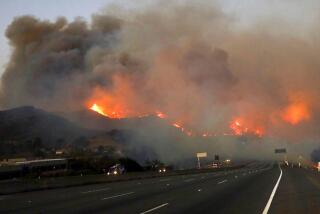Prop. 1 Focuses on Housing Expanding Police Force : Election: Proponents say bond is only way to fund new facilities. Critics call measure a boondoggle.
For the past few years, Los Angeles residents and politicians have concentrated on public safety as one of the top issues facing the city, pushing for a beefed-up police force to deal with urban crime.
Proposition 1, the $171-million police facilities bond measure on Tuesday’s ballot, now shifts attention toward how to house the expanding force, including 600 new officers police expect to hire this year.
Both advocates and opponents of Proposition 1 agree that more space is needed for officers, many of whom work in overcrowded and dilapidated buildings. But the agreement ends there: Proponents argue that the bond issue is the only way to fund the construction projects, but opponents contend that the proposal is a financial boondoggle born of pork-barrel politics.
The bond measure, which requires a two-thirds majority vote to pass, would raise property taxes by an average of about $10 a year per household for the next 25 to 30 years. The money would pay for construction of new police stations in the San Fernando Valley and the Mid-Wilshire District, replacement stations in the Hollenbeck and Rampart divisions, and three new parking structures.
To Los Angeles City Councilman Richard Alarcon, the architect of Proposition 1, the measure represents the only way to ensure that police get the modern facilities they deserve and that they require to fulfill their duties.
“What good is it if we have more police if their efficiency is hampered by the poor facilities they have to work out of?” Alarcon said.
He and other backers of the bond issue, who have drummed up nearly $300,000 in campaign money, contend that the new stations would lift police morale and cut the time it takes for officers to respond to calls.
But detractors oppose increasing the city’s bond debt. Attorney Richard Close, president of the Sherman Oaks Homeowners Assn., said lavish new facilities are not the answer.
“If response time is the issue, then let’s have substations. That’s the way to go,” Close said.
He noted the failure of a similar bond issue passed in 1989 to deliver the projects voters had expected. Having vastly underestimated construction costs, city and police officials were forced to abandon more than half of the 32 projects that the $176 million in bonds were supposed to have funded, including the new Valley station.
Proposition 1 supporters acknowledge that the “broken promises” argument is the one most likely to turn off voters. But the campaign hopes to convince the voters that the city is ready to find ways to cut the costs and the red tape that has held up projects in the past.
In a flurry of mailers sent out within the last few days, the campaign touts the recent donation of land in Panorama City by General Motors for a new Valley station. Supporters of the ballot measure, including Mayor Richard Riordan and Police Chief Willie L. Williams, say it shows the city’s commitment to expediting police facilities construction.
Gordon Murley, head of the San Fernando Valley Federation, which represents 19 Valley homeowners groups, said the promise of citizen oversight persuaded his organization to endorse Proposition 1, despite the federation’s reputation for fiscal conservatism.
The campaign on both sides has been low-key. Proponents are relying mostly on phone calls to likely voters and target mailings to residents in the 5th and 10th City Council districts, which are holding runoff elections.
The need for a two-thirds super-majority to approve the bonds is a barrier to the measure’s success. So is a predicted low voter turnout, which traditionally favors more conservative, anti-tax voters, many of whom live in the Valley.
“The Valley’s where these measures win or lose,” said Richard Lichtenstein, a political consultant who worked on the successful bond measure effort in 1989.
Lichtenstein said Proposition 1 may well garner more than half of the vote, but he predicted that it would not clear the two-thirds hurdle.
“These are extremely difficult measures to pass,” he said.
More to Read
Sign up for Essential California
The most important California stories and recommendations in your inbox every morning.
You may occasionally receive promotional content from the Los Angeles Times.











